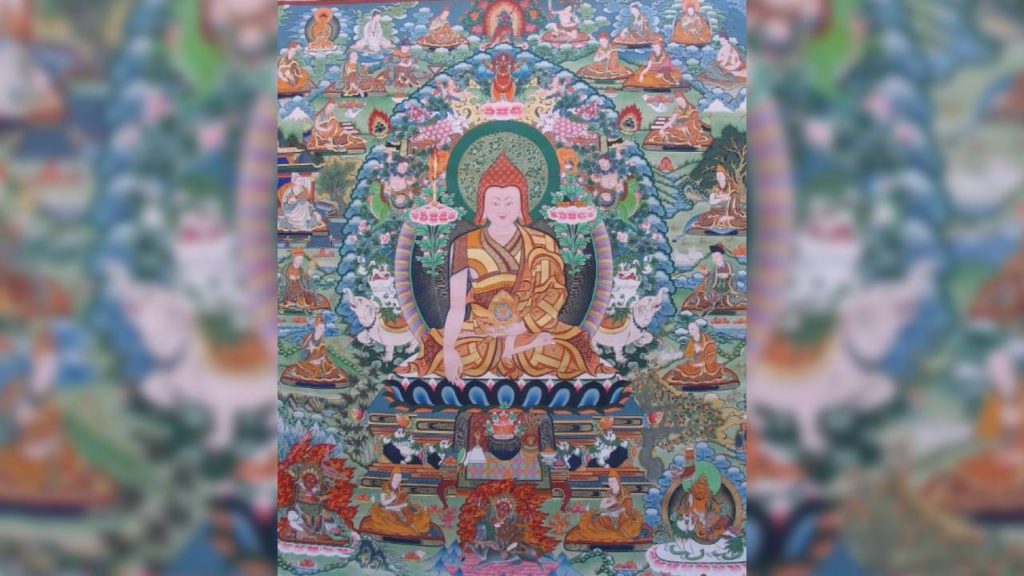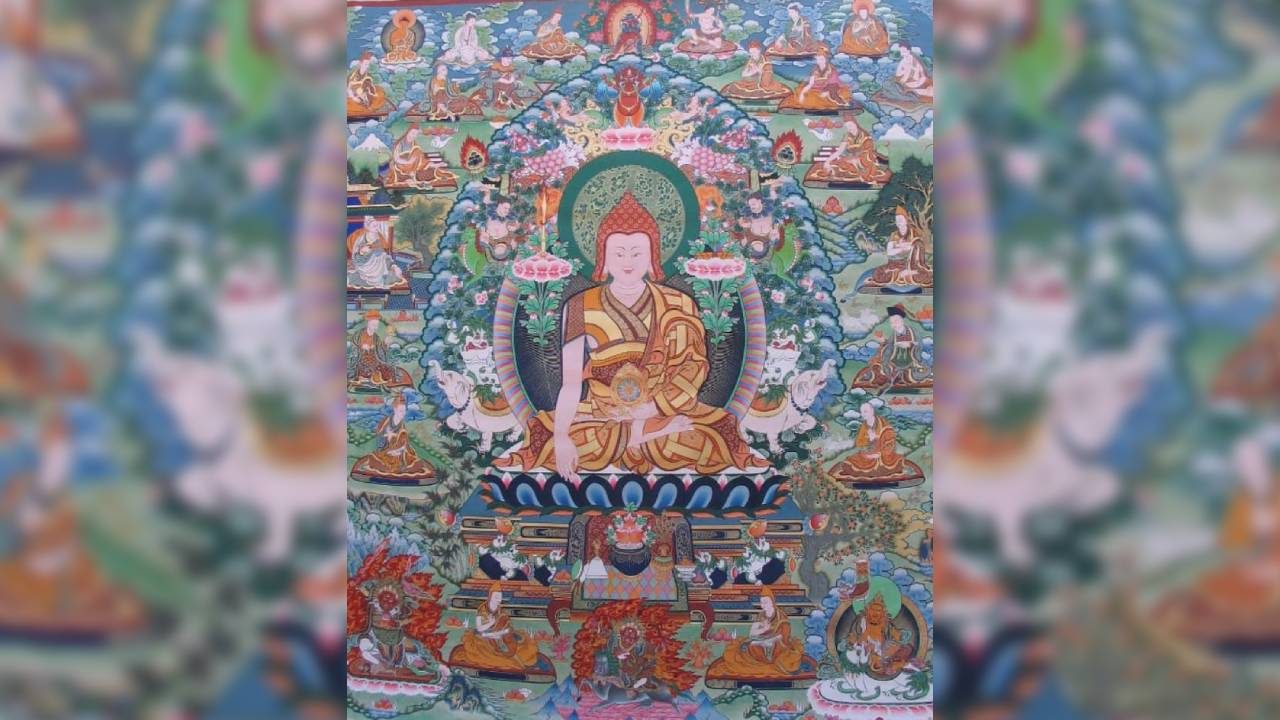
Tāranātha was born at Karak in 1575, into the hereditary line of the great Tibetan translator Ra Lotsāwa Dorje Drak. His Tibetan name was Kunga Nyingpo, but he is generally known by the name Tāranātha, which he received in a vision from a great Indian adept.
According to tradition, when he was about one year old he declared, “I am master Kunga Drolchok!” But this was kept secret for several years, and it was not until he was about four years old that he was brought to Kunga Drolchok‘s (kun dga’ grol mchog, 1507-1566) seat of Cholung Jangtse Monastery (chos lung byang rtse) and formally recognized as his incarnation. He then began years of intense study and practice under the guidance of a series of great masters, many of whom had been major disciples of Kunga Drolchok.
Guided by Kunga Drolchok’s disciple Jampa Lhundrub (byams pa lhun grub, d.u.), Tāranātha first studied and mastered various subjects of sutra and tantra. Then he received a vast number of tantric teachings and initiations, primarily of the Sakya tradition of Lamdre, from another of his predecessor’s disciples, Doring Kunga Gyeltsen (rdo ring kun dga’ rgyal mtshan, d.u.).
Kunga Drolchok’s disciple Draktopa Lhawang Drakpa (brag stod pa lha dbang grags pa, d.u.) taught Tāranātha many esoteric instructions, especially the Six Yogas and Mahāmudrā. Jedrung Kunga Pelzang (rje drung kun dga’ dpal bzang, 1513-1588), who was Kunga Drolchok’s nephew and successor on the monastic seat of Jonang Monastery (jo nang dgon), transmitted to Tāranātha the teachings of Kālacakra and the dharma protector Mahākāla that he had received from his uncle.
From Kunga Drolchok’s disciple Lungrik Gyatso (lung rigs rgya mtsho, d.u.), Tāranātha received many transmissions, especially the Kālacakra initiation, the explanation of the Kālacakra Tantra, the esoteric instructions of the Six-branch Yoga according to the Jonang tradition, and the collected writings Dolpopa Sherab Gyeltsen (dol po pa shes rab rgyal mtshan, 1292-1361). He is said to have gained a special experiential realization when he practiced the Six-branch Yoga.
When Tāranātha was fourteen years old, the Indian adept Buddhaguptanātha (d.u.) arrived in Tibet. This master became one of Tāranātha’s most important teachers, passing to him countless transmissions of tantric initiations and esoteric instructions. Tāranātha stated that his understanding of the secret mantra teachings was due to the kindness of Buddhaguptanātha alone.
Several other Indian yogins and scholars, both Buddhist and non-Buddhist, came to Tibet during Tāranātha’s lifetime, such as Bālabhadra, Nirvāṇaśrī, Purnananda, Purnavajra, and Kṛṣṇabhadra. They gave him instructions, taught scholarly topics, and joined him in translating Sanskrit manuscripts into Tibetan. Several of Tāranātha’s translations are now included in the Tibetan canonical collections of the Kangyur and Tengyur.
In 1588 Jedrung Kunga Pelzang, who had followed his uncle Kunga Drolchok as holder of the monastic seat of Jonang Monastery, enthroned Tāranātha at Jonang, although a formal ceremony of investiture did not occur until 1595. Tāranātha took upon himself the responsibility of causing Dolpopa’s insights to once again reach a wide audience. He was determined to revive what he saw as a priceless transmission lineage in danger of being lost.
During the 1590s the instruction manual of Dolpopa’s heir Chokle Namgyel (phyogs las rnam rgyal, 1306-1386) was still being used at Jonang to teach the Six-branch Yoga, but very few people understood the philosophical tenet of Dolpopa and his disciples. Tāranātha was even more concerned that some of the previous holders of the monastic seat of Jonang had given initiations and instructions according to the Jonang tradition, but had at the same time criticized and refuted Dolpopa’s vajra proclamations of the ultimate view of zhentong (gzhan stong) which Tāranātha felt was the secret teaching of all the buddhas and bodhisattvas. He now felt the need to defend the original views of Dolpopa through refutation of erroneous opinions, and to establish the correct interpretations according to his lineage.
During this period Tāranātha’s teacher Jampa Lhundrub advised him to restore the great stupa that Dolpopa had built about 260 years before at Jonang. Tāranātha put all his energy into the project. Just before the restoration work was finished, it is said that he had a marvelous vision one morning. The earth and sky seemed filled with countless people of all descriptions going in the same direction. He joined with them and arrived in a red, triangular valley with an incredible crystal mountain in the center. The mountain was totally filled with amazing stupas of different sizes, and in each stupa infinite buddhas and bodhisattvas were speaking back and forth about the dharma. Flowers fell from the sky like rain, and many other miraculous signs occurred. All of the people were making offerings to the crystal mountain filled with stupas, and chanting a series of verses in unison. Awestruck, Tāranātha asked about the mountain, and was told that it was the Dhānyakaṭaka Stūpa, where the Buddha is believed to have first taught the Kālacakra Tantra. Tāranātha later felt that perhaps this vision had occurred because everyone had been working so intensely to complete the restorations of the great stupa at Jonang.
In 1604, after a decade of efforts to revive the original Jonang teachings, all of Tāranātha’s work was threatened by serious political conflict between the regions of Jang (byang) and Tsang. Jonang Monastery itself was in immediate danger of being attacked by hostile armies. While meditating at Dolpopa’s great stupa, Tāranātha became despondent, and, seeing all his efforts about to be wiped out and the tradition itself perhaps destroyed, wished only to go into retreat far away from all the troubles created by deluded and impassioned people. But Dolpopa then appeared to him in a vision, encouraged him to continue as before, and assured him that his efforts would not be in vain. The next night Tāranātha prayed to Dolpopa and experienced a vision of a bodhisattva who spoke a quatrain of verse. As a result of these events, Tāranātha said he gained realization of Dolpopa’s true intentions as expressed in his zhentong teachings, and all his uncertainties and doubts were completely removed. He felt that a great key had been placed in his hands to open the doors of all the Buddha’s doctrine. As an expression of his realization he composed a versified text entitled Ornament of the Zhentong Middle Way (gzhan stong dbu ma’i rgyan), which is one of his most important works solely devoted to the explication of the zhentong view. Tāranātha said that he received several prophecies from Dolpopa, and thereafter met him many times, both actually and in dreams. He further commented, “That is the reason I am now an expert in the great omniscient Dolpopa’s view and preserve his true intentions.”
Tāranātha had countless such visions during his life. For example, many times during the years 1618 and 1619 he experienced visions of the Kalapa court of the Shambhala emperors, beheld the rulers themselves, and heard their teachings. He felt that these visions were a result of his belief that the ultimate view of all sutras and tantras was zhentong Madhyamaka.
In 1615 the powerful Tsang ruler Desi Puntsok Namgyel (sde srid phun tshogs rnam rgyal) provided a special piece of land and the necessary supplies and workers to begin construction of a monastery to serve as a center for the teachings of the definitive meaning of the Buddha’s doctrine. This monastery, which was finally completed in 1628, became Tāranātha’s main residence and was known as Takten Damcho Ling (rtag brtan dam chos gling).
Shortly before his death, Tāranātha appointed his disciple Sanggye Gyatso (sangs rgyas rgya mtsho, d.u.) as his successor on the monastic seat of Takten Damcho Ling and made many prophetic statements about the Jonang tradition and the great political troubles that would soon sweep through Tibet. Unfortunately, Sanggye Gyatso passed away not long after Tāranātha himself. Thus another of the great master’s disciples, Kunga Rinchen Gyatso (kun dga’ rin chen rgya mtsho, d.u.), was appointed to the monastic seat and led the Jonang tradition for the next fifteen years.
